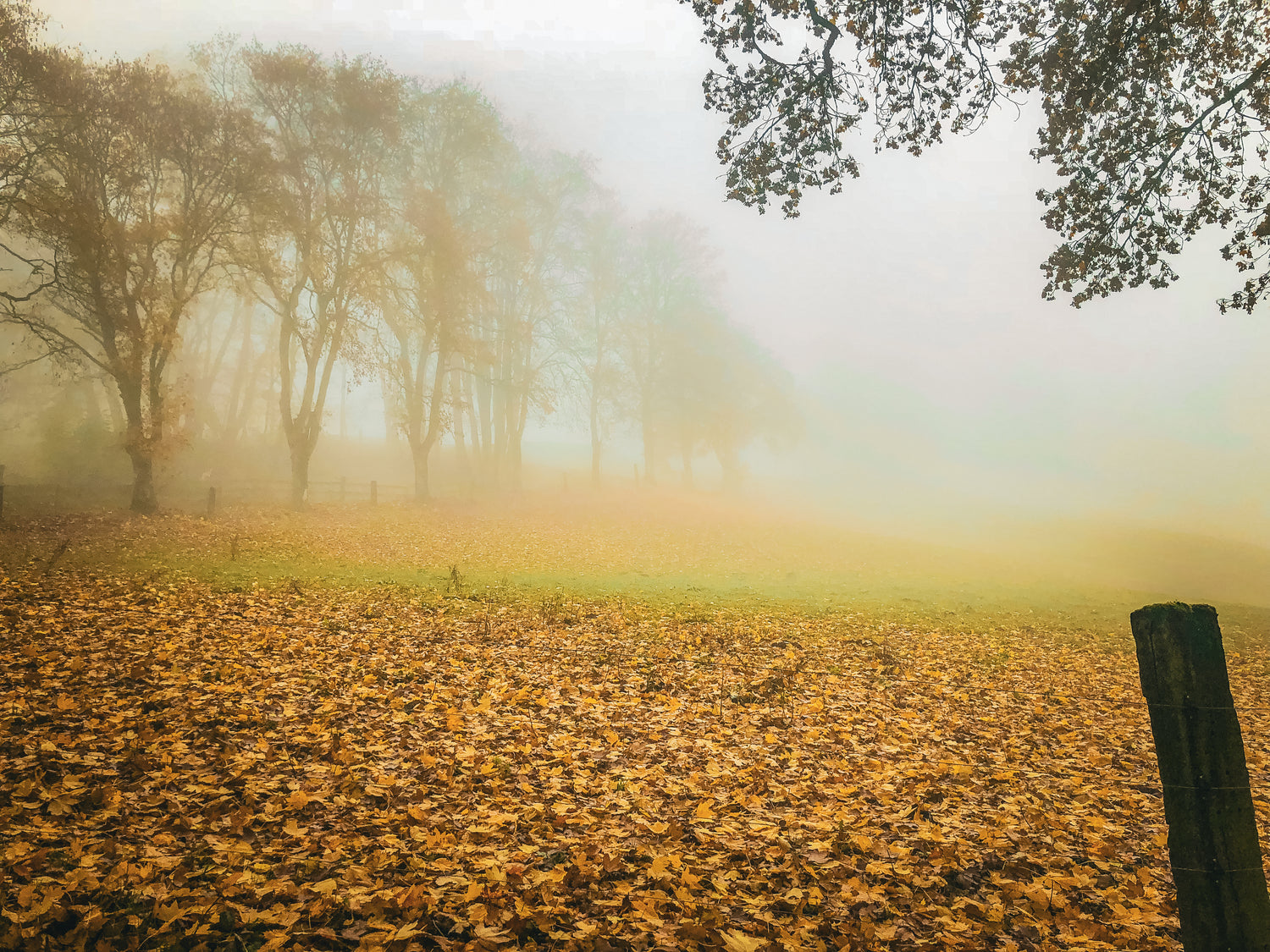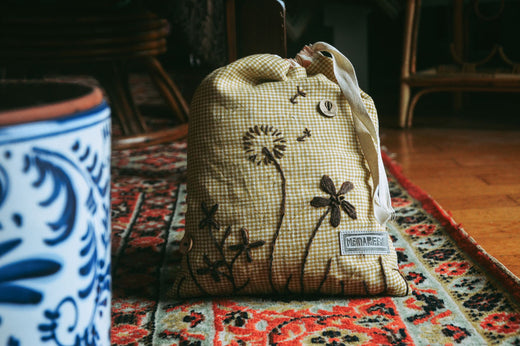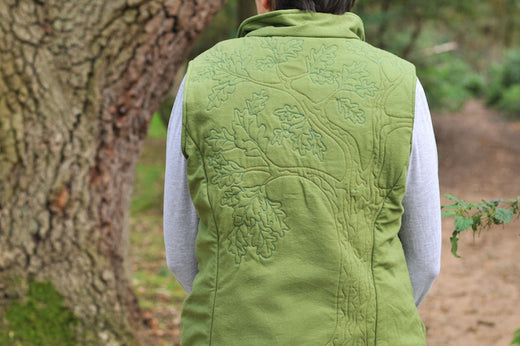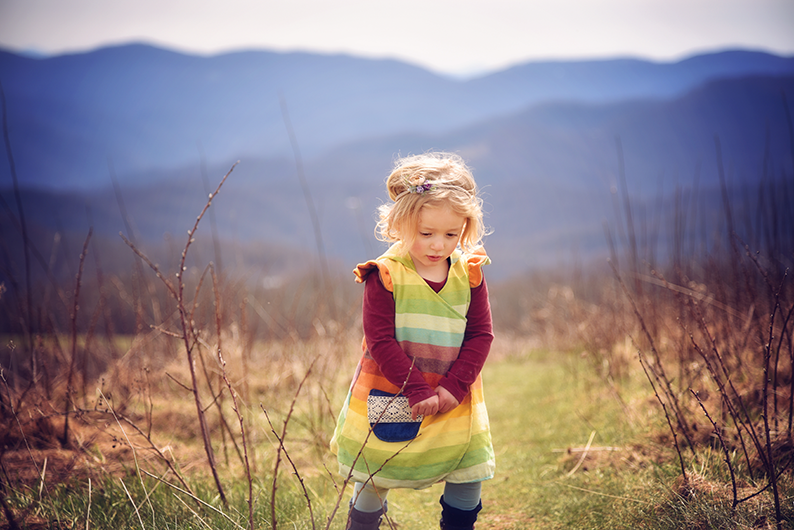Sewing and dressing for changing seasons can be a challenge, but Storyteller Laura Demostene is here to share her thoughts about creating a wardrobe that spans the seasons. Through clever choices of natural-fibre fabric and strategic layering, it is possible to enjoy favourite garments throughout the year. And as a bonus, Laura shares a quick and easy upcycling idea too, so be sure to read to the end!

Do you know that feeling? You know what I mean: there's that certain feeling in the air that something's about to change.
It is October, I am sitting on my balcony, the sun just appeared behind the gigantic fir tree standing next to our urban apartment building in the Swiss city of Berne. It is already 10:30am - way too late for the sun to shine completely on our balcony compared to the last months. I grab my cup of tea and begin to enjoy the warmth of it in my hands. And there is a reason for this: autumn has begun.


And so do fabrics by the way. When the season changes, it is not only the moment to say goodbye to everything that came along with it, but also to beloved clothes that made this particular season so special.
But does it have to be that way? And what do onions have in common with your wardrobe?
I would like to focus on change from a warm season to a colder one. Let's explore something that is called "layering" clothes. And to make it even better: how can different natural fibres help us to achieve the perfect climate for the skin.
First things first - the fibres. There are some which can be really helpful during the colder seasons, keeping you warm without making you drown in sweat, feeling cold afterwards and maybe catching a cold because of it. These are natural fibres which - in my opinion - kind of connect you to your environment more than others.
I hope that this overview helps you to make fabric choices the next time you are about to plan one of your beautiful Twig + Tale makes.
Wool

Wool fibres are obtained by taking the hair coat of certain animals like sheep, goats, alpacas and so on to make yarn for knitting or weaving fabrics. During fabrication there are certain differences in production which can impact the beautiful qualities of woolen garments: some process it very highly and some do not. But why?
You find highly processed woolen fibres (like merino for example) in functional clothing. The fibres still have some of the original qualities (like breathability) but there is one aspect that makes wool clothing extraordinary: the wool grease or lanolin. You might not find this in highly processed fabrics, but in those more natural and sustainably-produced ones, like boiled wool, wool fleece, other woven woolen fabrics and knitted ones like jersey, interlock, or wool-silk blends.
What is so special about keeping the wool grease - gathered from sheep wool - in these fibres? Wool grease or lanolin has some pretty awesome qualities:
- It nurtures dry and cracked skin
- It protects the fibres from environmental and usage related stress
- Due to its bacteriostatic abilities, it keeps your garment smelling nice because it doesn't absorb sweat odour
- It's breathable
- Even if you sweat, it absorbs a lot of the moisture for you to maintain a dry skin climate
- It does not wrinkle
- Most importantly, it keeps you warm
Silk
Silk is a fibre which is harvested from the cocoon of silkworms by boiling the cocoons until they unravel. This is why producing silk has caused a debate in terms of sustainability and animal rights. A vegan alternative for this fine silk would be Lyocell or Cupro since it is made out of plant cellulose.
But there is one byproduct of the silk fabrication which I want to highlight for you: bourette silk (also known as silk noil). It is made of the "waste" fibres during the silk productions - the thicker and shorter fibres - and still contains all of the natural advantages like:
- The very soft feeling on your skin
- Thermoregulation because of its breathability and ability to isolate: it keeps you cool on hot days and preserves your body heat during the colder seasons
- It is hypoallergenic and resists dust, fungus, mold and other allergens
- UV protection
- It absorbs moisture and dries fast at the same time
- Even if it is a delicate fibre, it is known for its wearability

The texture kind of reminds you of natural linen fabrics because of the little knots and bumps you find all over it. Bourette silk can be pretty heavy weight (compared to the light silk we all know) and extremely wearable and easy to process under your sewing machine because it does not slip away like "real" silk. Bourette silk fabric is perfect for blouses and shirts, like the Scenic Top, for flowy pants (imagine short Fernway Culottes or Coastal Cuffed Shorts), or jumpsuits. Due to its heavier fabric weight, I would not suggest making a full length dress or skirt out of it.
Bourette silk fabrics can be a great alternative for adults or especially children who will not accept woolen fabric on their skin (because of the itchiness some people experience).
Ramie or China Gras

Ramie is a fabric which I discovered (for myself) just recently and in my opinion it is just perfect for fall and winter. Ramie fibres are harvested from a plant species of the nettle family. It has been grown for over 3000 years in China to manufacture ropes, bank notes, kimonos, and shirts.
You see, something that has proved itself for over 3000 years to humanity might be a good fabric to add to your personal fabric stock.
Let's talk about its qualities:
- cooling effect because of its ability to absorb moisture
- tends to crinkle less after wearing it and some rounds in your washing machine
- similar haptic compared to natural linen
- the fibre is naturally white and does not need bleaching during fabrication
- very wearable and tear-proof
To me it is the perfect outer layer to an outfit or garment. It is practically made for becoming pants or vests. How many adventures might some Tree Climbing Pantaloons made of ramie witness with tear-proof pockets to hold every single special stone or shell a little human might find?! Or a Trailblazer Vest with a ramie outer, to withstand every outdoor occasion during the changing seasons.
Onions - now it is time...
... to put everything together. So what is it with onions? The onion technique or "onioning" describes putting on many different layers of garments. This is when you can make great use of the qualities of the fibres mentioned above.
Onioning is a perfect way to still wear your summer favourites during the colder seasons just by combining a few more layers. I personally cannot wait to wear my light muslin summer Meadow Skirt combined with some leggings, knitted socks and a favourite sweater!
Imagine: you are about to go on a long stroll through your favourite forest on a chilly and misty autumn morning. It is too dry for a raincoat, too moist to not put on a protecting shell around you and too cold to leave your jacket at home.
This is how one of my favourite Twig + Tale fall outfits would look:
I would wear thinner wool leggings under my heavy woolen Fernway Culottes. Before putting on my favourite knitted sweater to keep away the misty moisture in the air I might wear a Scenic Top made of bourette silk to keep warmth inside and some upcycled cuffs on my wrists (see upcycling tip at the end).

How to make Upcycled Cuffs
My personal tip for you is an upcycling idea which is great to wear with those 7/8 sleeves of your Scenic Top or calf-length Fernway Culottes. Do you have worn out (children's) legging or tights, or even a shrunken wool sweater? Make cuffs out of them to keep your wrists and ankles warm and cosy.

Here is what I do:

These children's wool-silk leggings are completely worn out and got some unfortunate moth holes during the summer.

Cut those legs off, fold the edge inwards and finish the seam with a twin needle, coverstitch or a wide zigzag stitch. If you have a similar spare fabric, you can of course add some narrow cuffs with your sewing technique of choice ;)

Quick upcycling done!

I wish you the most memorable moments during the changing seasons since they somehow carry a little bit of magic with them. Wherever you are on our beautiful planet: take care, slow down and try to take some time to enjoy and experience these transitions with every cell of your body.
With best regards and a hearty goodbye,
Laura - aka. L. von Güfeli, from Switzerland


See more of Laura's work here.





